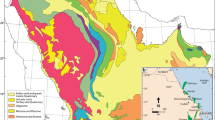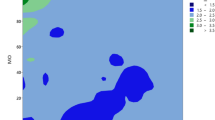Abstract
Several techniques for identifying and characterizing flow units of sandstone reservoirs have been proposed in the literature. The most established technique relies on the log–log plot of the reservoir quality index (RQI) versus the pore to matrix ratio (PMR). A straight line of slope unity across these points is extrapolated to PMR = 1 yielding the flow zone index (FZI). Samples that lie on the same straight line have similar pore throat characteristics and, therefore, constitute a flow unit; samples with different FZI values will lie on different parallel lines. In this study, this technique is extended to an Iranian carbonate reservoir. A genetic algorithm is employed to develop an empirical formula for predicting flow units in heterogeneous carbonate reservoirs. Conventional well log data as well as 410 core data, including porosity and permeability were available from the studied intervals. To establish the prerequisites for developing the intelligently derived formula, each set of the well log data was matched to its corresponding core data. Among them, 331 data points were used for developing the formula and 79 points verified the reliability of the obtained formula. The overall mean squared error and correlation coefficient between the logarithms of the measured and predicted FZI calculated through the respective formula for the test data are 0.1262 and 0.85, respectively. The results of the present study demonstrate the strength of the developed formula for predicting flow units of carbonate reservoirs. The proposed formula requires sonic, bulk density, deep laterolog, and corrected neutron porosity well logs.

Similar content being viewed by others
References
Al-Zahrani, M.A.; Moied, K.: Optimizing water quality monitoring stations using genetic algorithm. Arab. J. Sci. Eng. 28, 57–75 (2003)
Durairaj, S.; Devaraj, D.: Reactive power dispatch incorporating thyristor controlled series capacitors using improved genetic algorithm. Arab. J. Sci. Eng. 34, 173–185 (2009)
Al-Duwaish H.N.: Identification of Hammerstein models with known nonlinearity structure using particle swarm optimization. Arab. J. Sci. Eng. 36, 1269–1276 (2011)
Attia, A.F.; Al-Turki, Y.A.; Soliman, H.F.: Genetic algorithm-based fuzzy controller for improving the dynamic performance of self-excited induction generator. Arab. J. Sci. Eng. 37, 665–682 (2012)
Eslamian, S.S.; Gohari, S.A.; Zareian, M.J.; Firoozfar, A.: Estimating Penman–Monteith reference evapotranspiration using artificial neural networks and genetic algorithm: a case study. Arab. J. Sci. Eng. 37, 935–944 (2012)
Ebanks, W.J.: Flow unit concept-integrated approach to reservoir description for engineering projects. AAPG Meet. Abstr. 1(5), 521–522 (1987)
Aggoun, R.C.; Tiab, D.; Owayed, J.F.: Characterization of flow units in shaly sand reservoirs—Hassi R’mel Oil Rim, Algeria. J. Pet. Sci. Eng. 50, 211–226 (2006)
Mikes, D.; Barzandji, O.H.M.; Bruining, J.; Geel, C.R.: Up-scaling of small-scale heterogeneities to flow units for reservoir modeling. J. Mar. Pet. Geol. 23, 931–942 (2006)
Kazem-Zadeh, E.; Nabie Bid Hendi, M.; Rezaei, M.R.: The study of formation resistivity factor by using hydraulic flow units method in carbonate reservoir. J. Sci. 34(1), 13–21 (2008)
Soto, R.B.; Torres, F.; Arango, S.; Cobaleda, G.: Improved reservoir permeability models from flow units and soft computing techniques. A case study, Suria and Reforma-Libertad Fields, Colombia. SPE Paper 6965 (2001)
Aminian, K.; Ameri, S.; Oyerokun, A.; Thomas, B.: Prediction of flow units and permeability using artificial neural network. SPE Western Regional Meeting (California, USA, 19–24 May, SPE 83586) (2003)
Kadkhodaie-Ilkhchi, A.; Amini, A.: A fuzzy logic approach to estimating hydraulic flow units from well log data: a case study from the Ahwaz oilfield, South Iran. J. Petrol. Geol. 32(1), 67–78 (2009)
Shahvar, M.B.; Kharrat, R.; Matin, M.: Applying flow zone index approach and artificial neural networks for modeling techniques for characterizing a heterogeneous carbonate reservoir using dynamic data: case study of an Iranian reservoir. SPE Paper 132898 (2010)
Soleng, H.H.: Oil reservoir production forecasting with uncertainty estimation using genetic algorithms. In: Proceedings of the Congress on Evolutionary Computation, vol. 2, pp. 1217–1223 (1999)
Batyrshin, I.; Sheremetov, L.; Markov, M.; Panova, A.: Hybrid method for porosity classification in carbonate formations. J. Pet. Sci. Eng. 47, 36–50 (2005)
Ghiasi-Freez, J.; Kadkhodaie-Ilkhachi, A.; Ziaii, M.: The application of committee machine with intelligent systems to the prediction of permeability from petrographic image analysis and well logs data: a case study from the South of Iran. J. Pet. Sci. Technol. 30:20, 2122–2136 (2012)
Holland, J.H.: Adaptation in Natural and Artificial Systems. University of Michigan Press, Ann Arbor (1975)
Mohaghegh, S.: Virtual-intelligence applications in petroleum engineering: Part 2—evolutionary computing. J. Pet. Technol. 52, 40–46 (2000)
Amaefule, J.O.; Altunbay, M.; Tiab, D.; Kersey, D.G.; Keelan, D. K.: Enhanced reservoir description:using core and log data to identify hydraulic flow units and predict permeability in uncored intervals/wells. SPE Paper 26436, pp. 205–220 (1993)
Tiab, D.; Donaldson, E.C.: Petrophysics Theory and Practice of Measuring Reservoir Rock and Fluid Transport Properties. Elsevier Press, Oxford, pp. 112–132 (2004)
Matlab user’s Guide: Fuzzy logic, GA and Direct Search toolboxes, Matlab CD-ROM, by the Mathworks, Inc (2009)
Author information
Authors and Affiliations
Corresponding author
Rights and permissions
About this article
Cite this article
Hatampour, A., Ghiasi-Freez, J. & Soleimanpour, I. Prediction of Flow Units in Heterogeneous Carbonate Reservoirs Using Intelligently Derived Formula: Case Study in an Iranian Reservoir. Arab J Sci Eng 39, 5459–5473 (2014). https://doi.org/10.1007/s13369-013-0825-5
Received:
Accepted:
Published:
Issue Date:
DOI: https://doi.org/10.1007/s13369-013-0825-5




